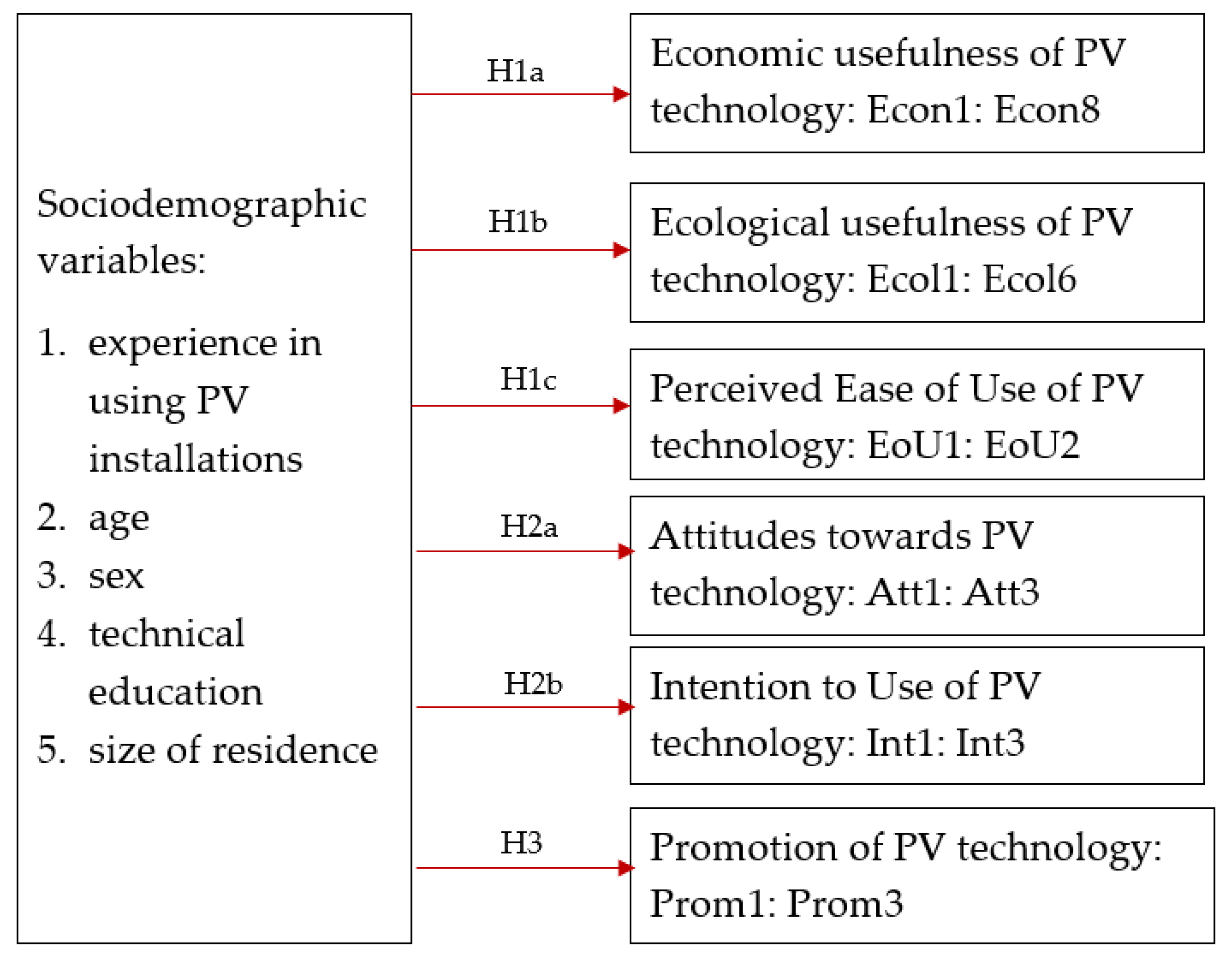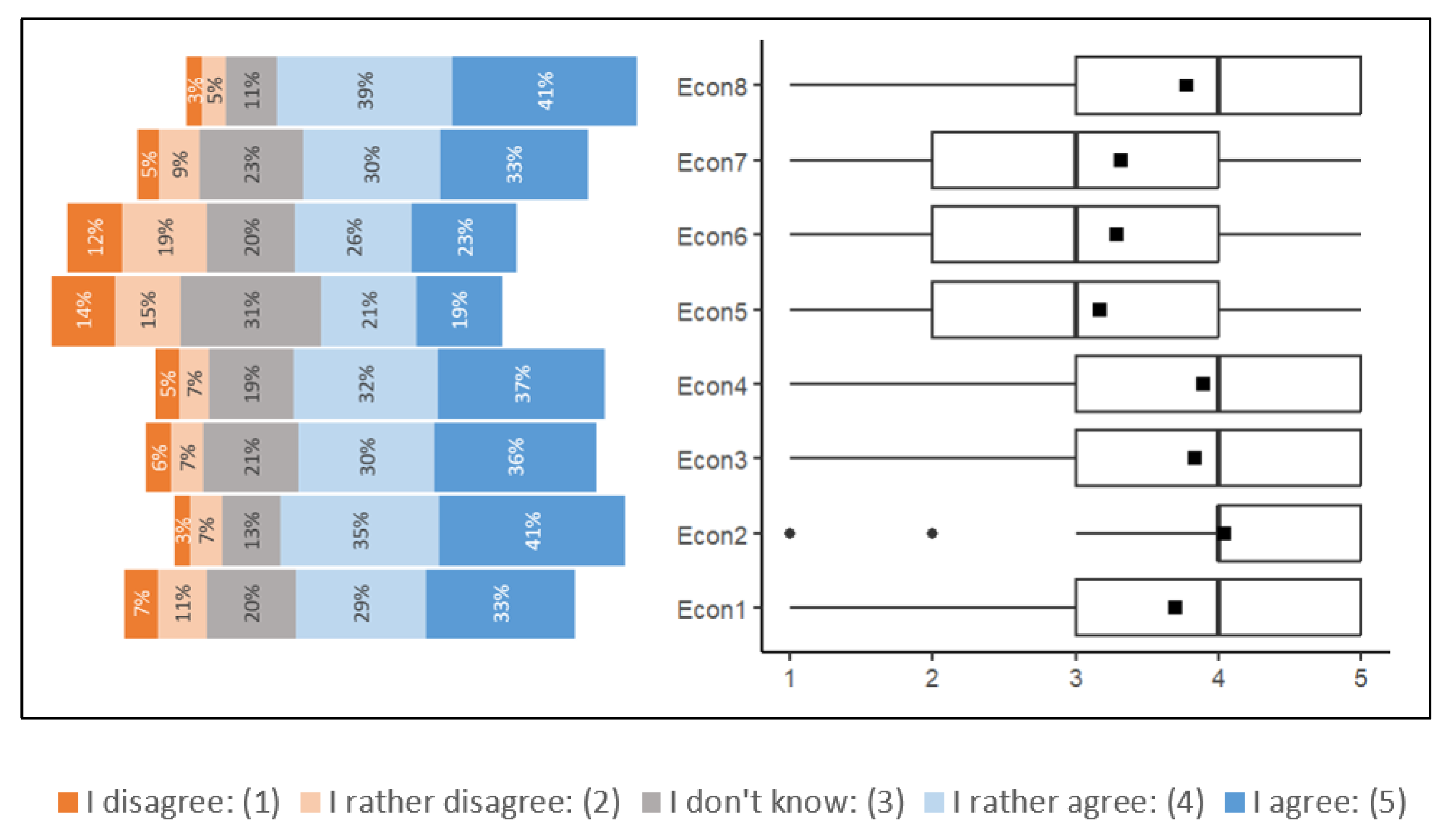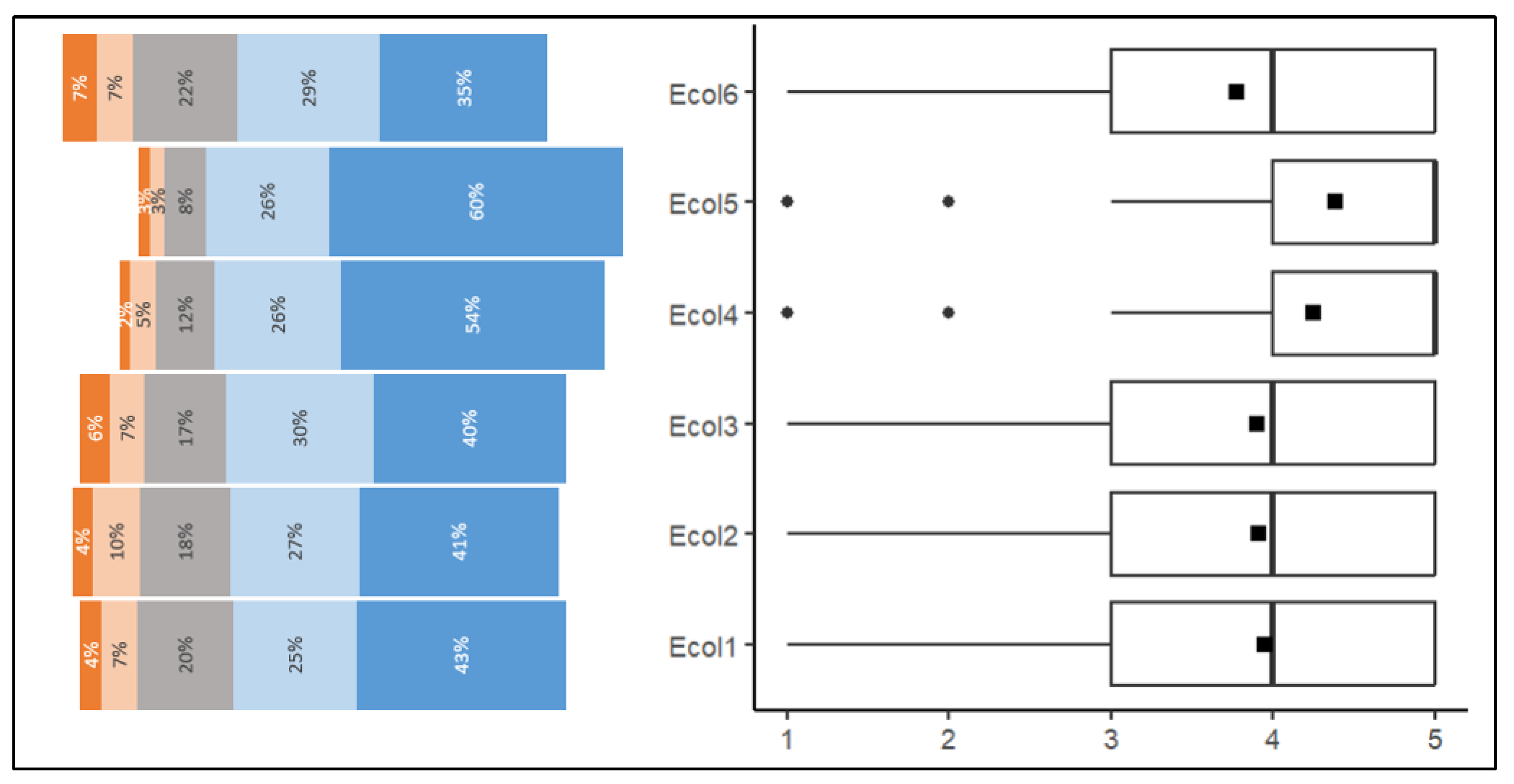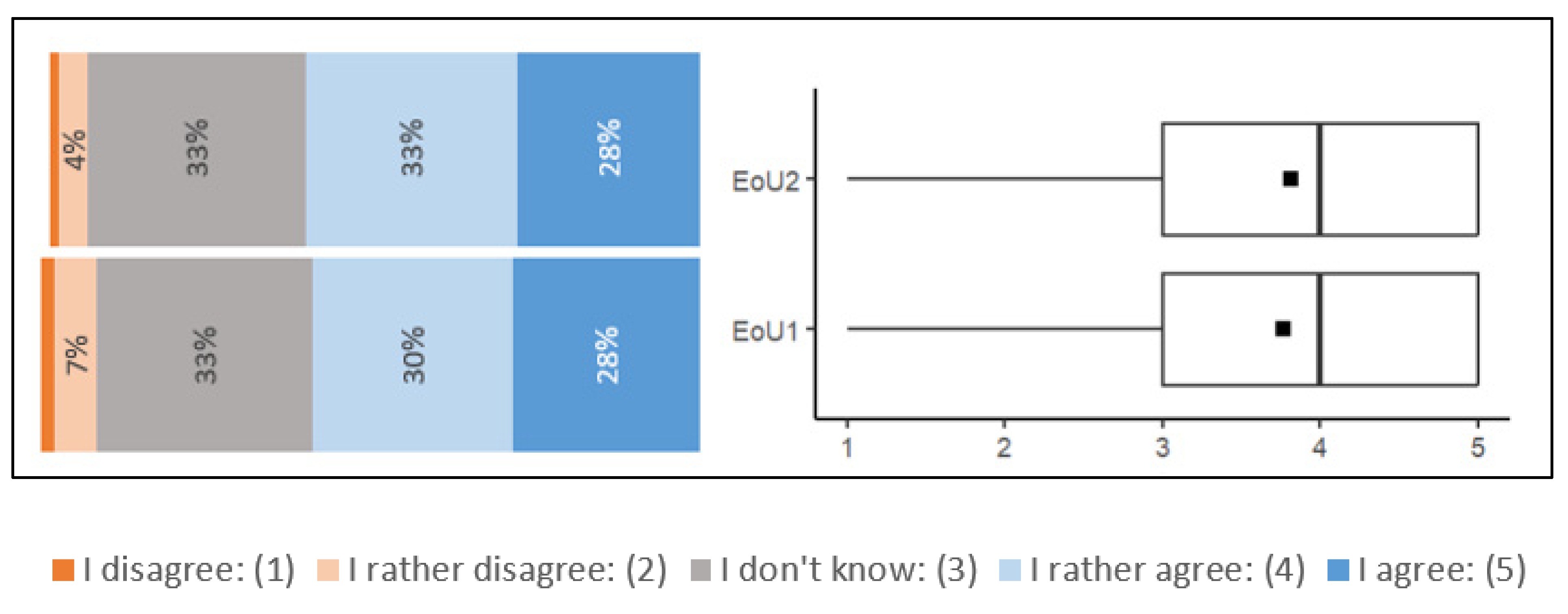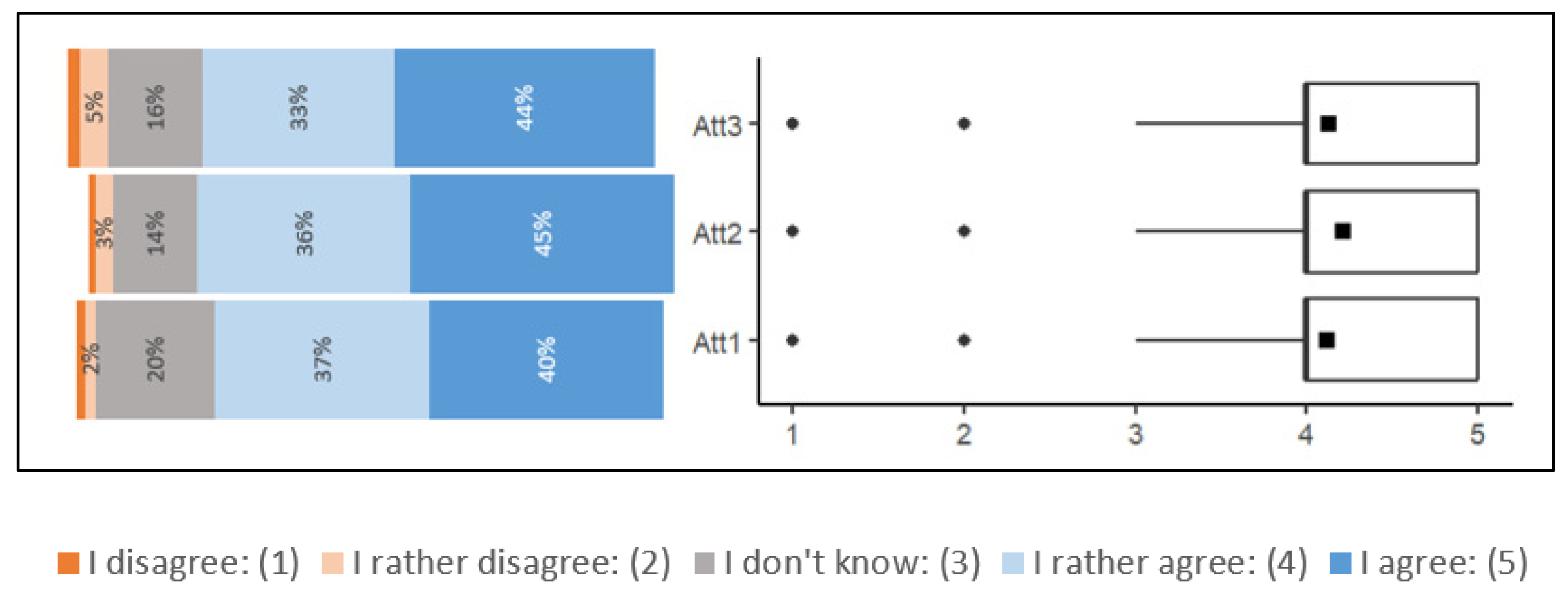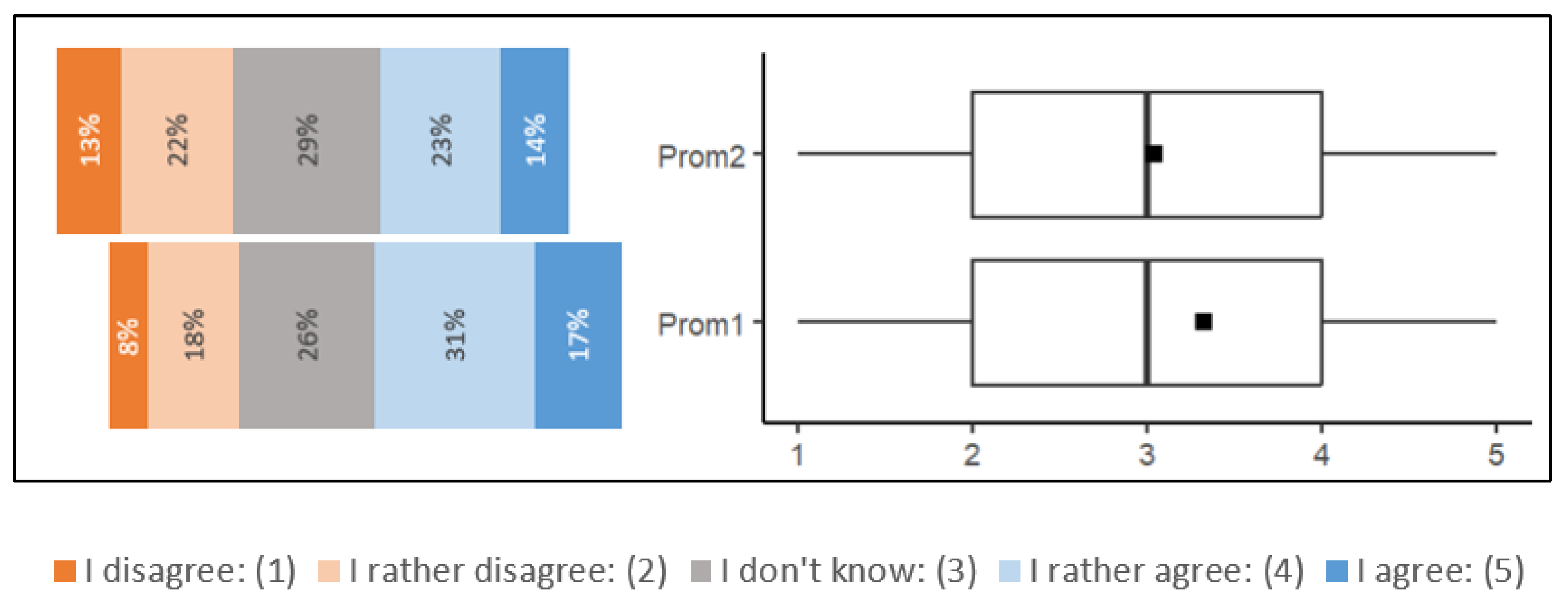1. Introduction
To mitigate climate change and become independent of fossil fuels, numerous activities are being undertaken to support the acquisition of electricity from clean and renewable sources. However, the adoption of new technologies is not immediate and problem-free, as it is associated with significant financial outlays and changes in the way of thinking, which is determined by many sociodemographic variables [
1]. Such conditions are also met by the technology of prosumer photovoltaic (PV) systems in Poland, which are the subject of this study. Many research works have already been dedicated to this topic, which indicates a considerable interest in this research area [
2,
3,
4,
5,
6,
7,
8,
9,
10,
11,
12,
13,
14,
15]. Researchers have made many attempts to identify factors influencing the adoption of prosumer PV technology using different approaches and models. Correlation studies are very often used in research [
3,
11,
13] and in modelling structural equations [
5,
7]. Despite this, the factors affecting the acceptance of prosumer PV systems are still under-researched. To fill this gap, we propose research based on the technology acceptance model (TAM). While researching the acceptance of PV technology in Poland, we decided on a complex research process, starting with the qualitative research presented in the article by [
9] and afterwards, the quantitative research based on Structural Equation Modeling (SEM) presented in the article by [
10]. Both articles were created as part of cooperation in the same author’s group. In the article by [
10], we answer questions about factors influencing the intention to use PV technology by analyzing paths on constructs (latent variables) resulting from the technology acceptance theory. In our opinion, this does not give sufficient insight into the observable variables shaping individual constructs. Thus, in the present article, we wanted to extend our earlier analysis to study the impact of categorical (sociodemographic) variables on the variables that make up these constructs.
This article aims to empirically examine the factors affecting the acceptance of photovoltaic technology in Poland. As the theoretical background of the research, the technology acceptance model was used, in which the usability and ease of use of technology determine attitudes towards it, and these, in turn, determine the intentions of use. Since each of these constructs belongs to the so-called latent variables, their examination is possible by measuring a number of observable variables. Therefore, we based our empirical research on measuring these variables and examining how their distributions are shaped and which sociodemographic variables influence this distribution.
In connection with the above aim, the article poses the following research questions:
Research Question 1: How is the usefulness and ease of use of PV technology perceived, and what variables shape this perception?
Research Question 2: How are the attitudes and intentions of using PV technology shaped, and what variables influence them?
Research Question 3: How is the promotion of PV technology activities perceived, and what variables influence it?
To answer these questions, surveys were conducted in March and April 2022 with the participation of 430 people. The collected data were analyzed using one- and two-dimensional statistical analysis and visualization techniques.
The originality of the considerations and research undertaken in this article results from the following circumstances: (1) filling the research gap in terms of the impact of sociodemographic variables on the variables measuring the utility, ease of use of the PV system, attitudes towards it and purchase intentions; (2) formulating recommendations for activities that enhance the acceptance of prosumer photovoltaic technology.
2. Theoretical Background
Factors influencing the adoption of innovative technology are being studied by scientists using many models. The most popular models are based on: the theory of reasoned action (TRA) [
16], the theory of planned behavior (TPB) [
17], the theory of diffusion of innovation (DOI) [
18], the technology acceptance model (TAM) [
19] and the unified theory of acceptance and use of technology (UTAUT) [
20]. In this study, we decided to choose a technology acceptance model. This is due to the fact that PV technology is relatively new in Poland, and therefore TAM, which is used to study the general conditions of the technology, can provide insight into these conditions. TAM treats the intentions of these behaviors as the basic construct shaping behavior (i.e., the use of a given technology), which in turn is determined by attitudes towards the researched technology. Attitudes are shaped by two constructs, i.e., the perceived usefulness of technology and its ease of use. Attitude is defined as the result of beliefs and judgments towards an idea or object [
21]. This means that they can be positive or negative.
Positive attitudes towards PV technology may result from the perception of this technology as clean, emission-free and resource-saving [
22,
23], and negative from high installation costs [
24]. This has a significant relationship with how the usefulness of this technology is perceived. The utility is a multidimensional construct, as it can be perceived in economic, ecological and even social terms.
The economic utility is related to the fact that a PV system can generate long-term benefits in the form of energy security and savings in electricity bills achieved thanks to this system [
9]. The more consumers pay for electricity bills, the more likely they are to invest in a PV system [
4]. For many potential investors, the benefits of subsidies and tax reliefs widely used by various countries to popularize PV technology may also be important. As research shows [
3,
24,
25,
26], these activities contribute to the dissemination of PV systems. However, high installation costs may be a problem—they can affect the decision of whether it is worth investing in this technology. According to research by [
24], the cost of installing PV is perceived as a disincentive to invest in this technology. Therefore, investors are usually people whose income and accumulated capital are large enough to buy and install PV systems [
4,
27,
28,
29]. In Poland, several economic incentives support investments in prosumer PV systems. These are tax breaks and programs that provide direct subsidies for investments. The most well-known programs include the nationwide government program “My Electricity” and numerous local government programs. In addition, research by [
11] revealed that the development of prosumer photovoltaics depends on GDP. In addition to income and accumulated capital, the willingness to invest in PV technology may be affected by age. Research by [
29,
30,
31] revealed that age is negatively correlated with the intention to purchase a PV system. Over time, the perception of PV technology changes, especially for people who have made the decision to invest in and use the technology. If the investment meets their expectations, they can decide to expand the system and invest further funds [
9].
Along with the dissemination of the idea of sustainable development and the escalating climate crisis [
32], ecological benefits, i.e., ecological utility, may also be important to many people. The use of green electricity reduces greenhouse gas emissions, saves natural resources, and thus enables ecological behavior [
3]. Evidence that beliefs about the ecological benefits of PV systems influence decisions are also provided by [
33,
34,
35,
36,
37]. However, as research has shown [
9], for some, the production process of PV panels and electronics related to this technology may not be ecological, and some may be convinced that the use of PV technology is not conducive to pro-environmental behavior. However, as in the case of economic utility, other demographic variables may affect ecological utility.
Acceptance of technology is also related to how easy it is to use. According to research by [
9], the system itself is established by professional companies and takes quite a short time, and the use of the system is assessed as maintenance-free. Over time, however, the system may need maintenance. It may also need repair. However, as research shows [
38,
39], decisions on investing in a PV system depend on household members’ traits. An important feature is the type of skills resulting from gender and education. People with a technical education may be more willing to make decisions about investing in PV technology. In Poland, technical education is chosen mostly by men. They also usually repair or supervise these repairs in households. This may suggest that men will be more willing to invest in PV systems, which is confirmed by research by [
4]; however, research by [
40] shows women as more likely to make such investments. As in the case of economic and ecological utility, other demographic variables may also influence the assessment of ease of use.
Given that the variables observed in the literature affect the acceptance of prosumer PV technology, we put forward three hypotheses corresponding to the first research question:
Hypothesis 1a. The assessment of the economic utility of a PV system is affected by such variables as experience in using the system, age, sex, technical education, and place of residence.
Hypothesis 1b. The assessment of the ecological utility of a PV system is affected by such variables as experience in using the system, age, sex, technical education, and place of residence.
Hypothesis 1c. The assessment of the ease of use of a PV system is affected by such variables as experience in using the system, age, sex, technical education and place of residence.
Due to the fact that the technology acceptance model assumes that the perceived usefulness of the technology and its ease of use influence the attitudes, and these influence the intentions of using this technology, and due to the fact that the importance of these relationships for prosumer PV technology has been confirmed in research by [
10], we put forward two more hypotheses regarding the attitudes and intentions of using PV technology, corresponding to the second research question:
Hypothesis 2a. Attitudes towards use of a PV system are affected by such variables as experience in using the system, age, sex, technical education and place of residence.
Hypothesis 2b. The purchasing of a PV system is affected by such variables as experience in using the system, age, sex, technical education and place of residence.
Intentions to use PV technology are also significantly influenced by the promotion of this technology. In Poland, a few programs financially support the installation of PV systems for prosumers. Several marketing campaigns in the media accompany them. In addition, companies installing PV systems run their advertising campaigns. The significant impact of the promotional policy has been demonstrated in the paper [
41,
42]. Empirical studies confirming the significance of this relationship in Poland are presented in the paper by [
10]. However, the impact of promotional policies may vary depending on age, gender, place of residence and familiarity with PV technology. In connection with the above, we put forward one more hypothesis corresponding to the third research question:
Hypothesis 3: The perception of activities related to the promotion of PV technology is affected by such variables as experience in using the system, age, sex, technical education, and place of residence.
5. Discussion and Conclusions
In this article, six related hypotheses were verified by answering the three research questions posed in the introduction. A summary of the hypothesis testing is provided in
Table 10.
Answering the first research question, it was established that the economic usefulness of prosumer PV technology is rated the highest from the cost perspective, both short-term (lowering electricity bills) and long-term (protection against rising electricity prices). In this way, our results correspond with the conclusions of the work by [
4]. Respondents also highly appreciated state financial subsidies supporting PV systems and highly assessed systems as capital investments. This allows us to conclude that our results are consistent with the research by [
3,
24,
25,
26]. It was also found that the variables that had a statistically significant impact on this assessment of variables related to economic utility were age and ownership of PV systems: higher ratings were given by younger people, and significantly higher ratings of PV systems were given by their current users. The high ratings of the younger group can be explained by the fact that the younger group, as it has less accumulated capital, appreciates the economic incentives for investment in PV systems. The influence of experience in using a prosumer PV system on its enthusiastic assessments has also been confirmed in qualitative research by [
9]. The research presented in this article confirms this relationship also at the level of quantitative research.
In terms of perceived ecological usefulness, it was found that the highest ratings were given to intentions to increase the production of green energy and to perceive PV heating as ecological. The impact of the photovoltaic system on reducing greenhouse gas emissions, saving natural resources and the overall positive impact of the PV system on ecological behavior and the environment itself was highly rated. The variables that statistically significantly affected this assessment of variables related to ecological utility were the possession of a PV system and age. Higher ratings were given by current users of PV systems and people from the oldest age group. High assessments of the ecological utility of PV systems in the older age group are an interesting finding, because in most studies it is the younger age groups that are indicated as more environmentally oriented.
The perceived ease of use of the PV system was rated high. The variables significantly influencing this assessment turned out to be all considered sociodemographic variables, except for age. Higher ratings were made by owners of PV systems, men, people with a technical education, and people from smaller towns. In terms of the impact of technical education, we confirm the conclusions indicated in the research by [
38,
39]. Residents of smaller towns are also the most common owners of PV systems in Poland. Such systems dominate in single-family buildings, which are more common in smaller towns than in large cities. This explains why the answers of PV system owners are related to the answers of residents of smaller towns.
Answering the second research question, it was found that attitudes towards the technology of prosumer PV systems are very favorable in terms of all the examined variables defining the tested construct. The variables that statistically differentiated the answers were experience in using PV systems, age, and size of the town. Current owners of PV systems gave the most enthusiastic ratings in terms of attitudes. The inhabitants of smaller towns did the same. On the other hand, in terms of age, it was the oldest age group that gave higher ratings. Thus, it can be seen that attitudes towards PV systems were determined more by ecological than economic considerations.
When examining the intentions of investing in PV systems, it was found that they are higher in the long term. The impact on the variables specifying investment intentions is determined by all sociodemographic variables examined, except for technical education. The owners of the systems showed significantly higher intentions, probably related to the expansion of these systems. Residents of smaller towns also showed higher intentions. Men assessed their intentions in terms of investing in a prosumer PV system higher than women. In the short term, older age groups are more likely to invest in PV systems, and in the longer term, younger people. In the case of the older age group, this is most likely due to the accumulated capital and a higher degree of perceived ecological usefulness of such an investment. In this way, our conclusions regarding the impact of accumulated capital on the intentions of investing in PV technology correspond to the conclusions from the research by [
4,
27,
28,
29]. At the same time, however, our research differs slightly from the conclusions of [
29,
30,
31] regarding the impact of age on investments in prosumer PV technology. We notice that the influence of age on investment intention is shaped differently depending on the long-term or short-term perspective.
Answering the third research question, ambiguous assessments of the perception of activities related to the promotion of prosumer PV systems were established. It was established that the only sociodemographic variable that determines statistically significant differences is age. In this regard, younger people perceived promotional activities more favorably than older people. This is most likely due to the fact that the investment intentions of this age group are postponed. Moreover, the younger group, due to the fact that it has less accumulated capital, appreciates the economic incentives for this type of investment more, which was demonstrated when discussing the perception of the economic utility of prosumer PV systems.
Practical research implications
In 2019–2022, almost 12 GW of capacity based on photovoltaic technology was installed in the Polish power system. The largest part of the power was connected to the distribution network as micro-systems, both at low and medium voltage. At the end of 2022, in accordance with [
2], the number of micro-systems connected to the network of distributors grouped in the Polish Power Transmission and Distribution Association was 1,220,299 units, and the installed capacity was 9254 MW (over 9 GW). In 2022 alone, 356,000 systems with a capacity of 3.18 GW were connected.
The above data on the increase in the number and capacity of micro-systems, including prosumer micro-systems, to the development of which the “My Electricity“ program, launched in 2019 and continued in 2023, contributed to the development, testify to the success of the program itself, both in terms of investment decisions and shaping attitudes towards the new technology of non-emission electricity production. Due to the recent change to a less favorable formula for the consumption of electricity produced by prosumers for their own needs (the net metering formula was changed to net billing during the settlement period, in which 70–80% of the energy was introduced to the power grid so that the excess energy is sold to the grid and the missing energy is purchased), the interest in prosumer investments has decreased. The ability to connect new systems to the grid, especially low voltage, is also limited by regulatory possibilities and ensuring the possibility of receiving all energy during the peak hours of its production. Thus, it is recommended first to ensure that the grid is adapted to the new conditions. Subsequently, it would be necessary to introduce such preferential settlements that would increase the interest in prosumer investments again. Taking into account the aforementioned two limitations and the research results, the following should be pointed out:
attitudes towards photovoltaic technology, as well as economic motives, despite the less favorable way of settling the energy produced in the prosumer system from 2022, will not cause withdrawal from investment decisions,
an additional argument in favor of the above conclusion is the growing uncertainty about electricity prices and their increase related to the increase in the prices of emission allowances (quotations above EUR 100 per allowance at the beginning of 2023),
growing environmental awareness and green deal policy are building sustainable attitudes towards energy solutions (electricity, heat, cooling) for households that are carbon footprint-free in the long run.
In addition to economic and ecological factors, ease of use and the attitudes towards prosumer photovoltaics built on them, an additional factor that has not been studied but which should be taken into account after Russia’s invasion of Ukraine is the security of distributed energy systems. Experiences resulting from the physical destruction of large-scale power generation infrastructure and transmission systems in war conditions or natural disasters should be pointed out. Distributed micro-energy infrastructure can be more easily restored and used in the face of the aforementioned threats.
